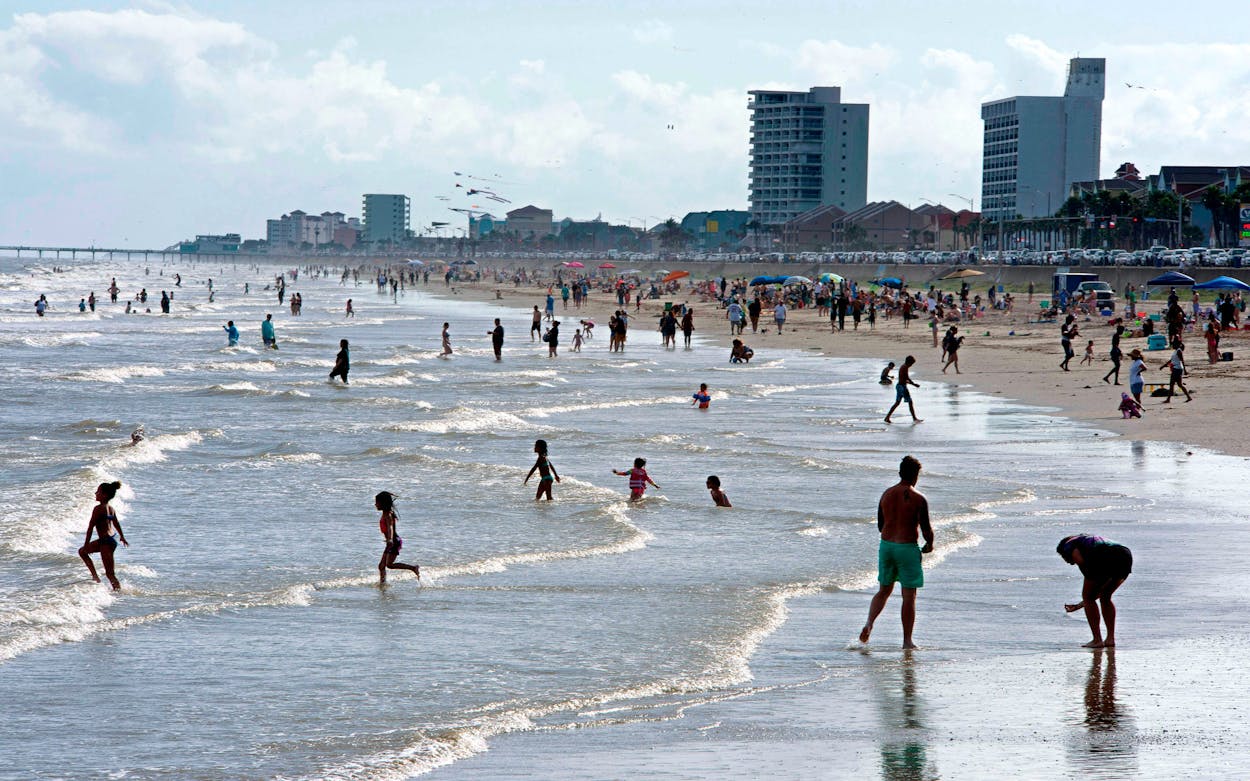Please refrain from eating while reading this.
As the classic children’s book reminds us: everyone poops. But that doesn’t mean we want to swim in it. That’s why a recent report reminding us about the infestation of human waste in Gulf waters has us grimacing.
In 2022, sixty-one Texas beaches were tested for fecal indicator bacteria, according to Environment Texas, a nonprofit based in Austin. Potentially unsafe levels of fecal contamination were recorded for at least one day in 90 percent of beaches tested. These findings mean the water at most Texas beaches exceeded the Environmental Protection Agency’s enterococcus “Beach Action Value,” a conservative metric states can use to issue advisories and protect people from swimming in potentially unsafe waters.
Along the Texas coastline, Cole Park in Nueces County had the highest percentage of potentially unsafe test days in 2022, with notably high fecal levels found on more than half of the days it was tested. Other locations in Nueces County with percentages higher than 30 include Ropes Park, Poenisch Park, and the Corpus Christi Marina. Beaches in Galveston County and Harris County also appear on the top-ten list, with percentages of polluted days ranging from 21 to 28 percent.
According to Environment Texas, rapid development, impervious surfaces, and outdated sewage systems are some of the factors contributing to water pollution. The increase of paved surfaces leads to more polluted stormwater entering rivers, bays, and coastal waters. Destruction of forests and wetlands worsens the issue.
Engaging in recreational activities such as surfing, swimming, and wakeboarding in contaminated waters is not only an unpleasant thought—it also presents a danger to human health. The American Journal of Public Health published an analysis in 2016 examining the risks of gastrointestinal illnesses associated with these types of recreational activities. It found that 21 percent of the diarrhea episodes of the subjects in the study were related to water exposure.
According to the EPA, illnesses related to contact with polluted water are generally short-lived and can be easily treated. The most common symptoms associated with polluted water include nausea, vomiting, diarrhea, stomachache, headache, or fever. Children, the elderly, and individuals with weakened immune systems are more likely to develop such illnesses after a day of swimming. The EPA recommends looking for advisory signs at beach entrances that say to avoid swimming due to bacteria. It also advises against swallowing water or swimming with open wounds.
Texas Beach Watch is an initiative from the Texas General Land Office and the EPA that warns potential swimmers when the water is highly contaminated with enterococcus through an interactive map, with the goal “to provide the public with information about water quality at selected recreational beaches along the Texas coast.” Texas Beach Watch maintains an easy-to-navigate and color-coded map: green means low contamination levels; yellow, medium; and red, high. To keep the map updated, the organization collects samples each week during the summer and in March (due to spring break), and every two weeks throughout the rest of the year. Once the data is collected and analyzed, it is fed into the map. The program collects more than seven thousand samples each year and monitors 172 sites along 61 Texas recreational beaches. According to the General Land Office, since Texas Beach Watch was established, no Texas beach has been closed due to high bacteria levels.
As Texas Monthly reported last year, the Texas Beach Watch testing regime isn’t as comprehensive as those of other states with fewer miles of coastline; researchers working under Jeffrey Turner, an associate professor of marine biology at Texas A&M–Corpus Christi, concluded the level of human waste in Corpus Christi waters was greater than what the state acknowledged. Turner is now working with the local chapter of the Surfrider Foundation’s national Blue Water Task Force, leading citizen-science efforts to monitor water quality at some recreational beaches in Texas. The initiative started when Texas surfers began getting ill after spending time in the water. They approached Turner, and the group started a project in which surfers gather the water samples themselves while Turner’s laboratory conducts tests.
Turner is also actively working on a study sampling privately owned canal communities, which are not monitored by Texas Beach Watch. The initiative, funded by the Coastal Bend Bays & Estuaries Program, involves citizen scientists, and sample-collection trips have been taking place since February. Turner says the final report will be completed by the end of the year.






